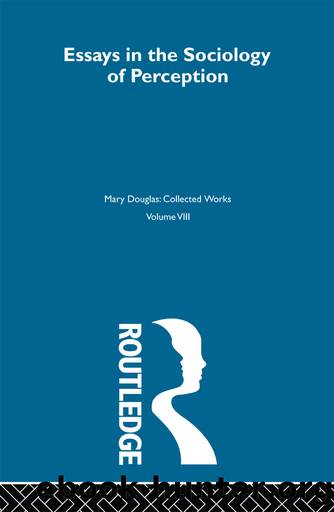Essays on the Sociology of Perception by Mary Douglas

Author:Mary Douglas [Douglas, Mary]
Language: eng
Format: epub
Tags: Social Science, Anthropology, General, Cultural & Social, Archaeology, Reference
ISBN: 9781134557509
Google: BZ1TAQAAQBAJ
Publisher: Routledge
Published: 2013-10-16T05:51:49+00:00
Spectacle
Spectacle will be discussed cursorily: within it there is the greatest attenuation of the relationship between the individual and society. Spectacle connotes the exhibition of a âspecially prepared or arranged display of a more or less public natureâ (OED: 553). Such a tableau is often grandiose and exaggerated; and it is viewed at a distance often by choice in both physical and social terms. In its internal organization the spectacle is somewhat of a world unto itself: it can function without outside participation, for it institutionalizes the distinction between the active performer and the passive spectator (MacAloon 1977: 3). The latter may choose to view the spectacle more or less on his own terms; conversely the spectacle can exist virtually without onlookers. Thus the autonomy of the spectacle is matched by that of the individual viewer. As MacAloon (1977: 7) points out, the spectacle, unlike the festival, does not depend on creating a particular mood among participants or viewers. Instead, the mood of spectacle may be one of diffuse wonder or awe; so that the spectator can decide for himself, in large measure, how to interpret the information he receives. This lack of guidelines for the individual viewer distinguishes the spectacle from the other events considered and contributes to the autonomy of both the event and its audience respectively.
Spectacle tends to be associated with the low-group side of the diagram. When roles are highly insulated passive adaptation is a common response to everyday life. The socially-reflexive demands, made on the viewer by the spectacle, are minimal. There is no requirement that the spectator relate the event to a cosmology which, at any rate, is hardly developed. Nor need the viewer relate the event to the boundaries of groups, which may be nonexistent. Instead, the event mirrors the compartmentalization of roles, in a simplistic manner. In this context would be located the Roman âbread and circusesâ, and similar themes.
The low-group/grid context is an apt site of meeting for the joking relationship and the spectacle. Through the former, individuals actively reflect upon one another in a basically dyadic pattern. The latter involves the mass participation of individual isolates. The pattern of performer and spectator in the spectacle is also essentially dyadic; for persons relate as individuals to what they are viewing, whether these are athletic events (MacAloon 1977; Peacock 1974), or other forms of entertainment. Particularly in this context, media of mass entertainment encourage the perpetuation of the dyadic relationship between spectator and performer. Thus, large numbers of persons remain quite individuated, even when together, while they passively absorb dramatic projections which themselves do not necessarily reflect upon any reality known to these spectators. In an important sense, the self-absorbed individualist and the autonomous spectacle mirror one another within the context of a weak group/weak grid.
Through spectacle, the self is freed; but its reflexive capacity is turned largely inward. In the weak-group/strong-grid context, this involution contributes to the insulation of roles. In the weak-group/weak-grid context, the reflexivity of this involution may be closer to that of fantasy than it is to commentary on reality.
Download
This site does not store any files on its server. We only index and link to content provided by other sites. Please contact the content providers to delete copyright contents if any and email us, we'll remove relevant links or contents immediately.
Cecilia; Or, Memoirs of an Heiress — Volume 1 by Fanny Burney(32029)
Cecilia; Or, Memoirs of an Heiress — Volume 3 by Fanny Burney(31441)
Cecilia; Or, Memoirs of an Heiress — Volume 2 by Fanny Burney(31389)
The Great Music City by Andrea Baker(30761)
We're Going to Need More Wine by Gabrielle Union(18611)
All the Missing Girls by Megan Miranda(14633)
Pimp by Iceberg Slim(13757)
Bombshells: Glamour Girls of a Lifetime by Sullivan Steve(13670)
Fifty Shades Freed by E L James(12892)
Talking to Strangers by Malcolm Gladwell(12835)
Norse Mythology by Gaiman Neil(12795)
For the Love of Europe by Rick Steves(11342)
Crazy Rich Asians by Kevin Kwan(8867)
Mindhunter: Inside the FBI's Elite Serial Crime Unit by John E. Douglas & Mark Olshaker(8672)
The Lost Art of Listening by Michael P. Nichols(7141)
Enlightenment Now: The Case for Reason, Science, Humanism, and Progress by Steven Pinker(6857)
The Four Agreements by Don Miguel Ruiz(6293)
Bad Blood by John Carreyrou(6260)
Weapons of Math Destruction by Cathy O'Neil(5805)
